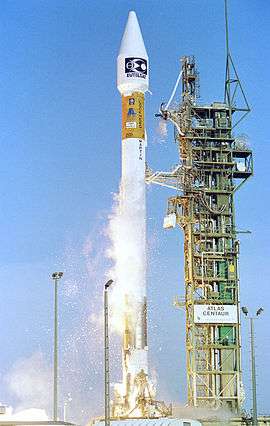Atlas III
 The maiden flight of the Atlas III | |
| Function | Medium expendable Launch vehicle |
|---|---|
| Manufacturer | Lockheed Martin |
| Country of origin | United States |
| Size | |
| Height | 52.8 m (173.2 ft) |
| Diameter | 3.05 m (10 ft) |
| Mass | 214,338 kg (472,338 lb) |
| Stages | 2 |
| Capacity | |
| Payload to LEO |
IIIA: 8,640 kg (19,040 lb) IIIB: 10,218 kg (23,630 lb) |
| Payload to GTO |
IIIA: 4,055 kg (8,939 lb) IIIB: 4,500 kg (9,900 lb) |
| Associated rockets | |
| Family | Atlas |
| Launch history | |
| Status | Retired |
| Launch sites | SLC-36B, CCAFS |
| Total launches |
6 (IIIA: 2, IIIB: 4) |
| Successes |
6 (IIIA: 2, IIIB: 4)[1] |
| First flight |
IIIA: 24 May 2000 IIIB: 21 February 2002 |
| Last flight |
IIIA: 13 March 2004 IIIB: 3 February 2005 |
| First stage | |
| Engines | 1 RD-180 |
| Thrust | 4,148.7 kN (932,670 lbf) |
| Specific impulse | 311 sec |
| Burn time | 132 seconds |
| Fuel | RP-1/LOX |
| Second stage (Atlas IIIA) - Centaur (SEC) | |
| Engines | 1 RL-10A |
| Thrust | 99.2 kN (22,290 lbf) |
| Specific impulse | 451 sec |
| Burn time | 738 seconds |
| Fuel | LH2/LOX |
| Second stage (Atlas IIIB) - Centaur (DEC) | |
| Engines | 2 RL-10A |
| Thrust | 147 kN (41,592 lbf) |
| Specific impulse | 449 sec |
| Burn time | 392 seconds |
| Fuel | LH2/LOX |
The Lockheed Martin Atlas III (known as the Atlas II-AR early in development[2]) was an American orbital launch vehicle, used between 2000 and 2005.[3] It was the first member of the Atlas family since the Atlas A to feature a "normal" staging method, compared to the previous Atlas family members, which were equipped with jettisonable engines on the first (sustainer) stage.
Description
The Atlas III consisted of two stages. The first stage was new, but the upper stage was the Centaur, which is still in use today on the Atlas V EELV. The first stage engines were Russian RD-180s, which are also used by the Atlas V. The Atlas III was produced in two versions. The baseline was the Atlas IIIA, but the Atlas IIIB, featuring a twin-engine version of the Centaur upper stage, was also produced.[1]
Launches
The maiden flight of the Atlas III occurred on May 24, 2000, launching the Eutelsat W4 communications satellite into a geosynchronous orbit. All Atlas III launches were made from Space Launch Complex 36B at Cape Canaveral Air Force Station. The Atlas III made its sixth and last flight on February 3, 2005, with a classified payload for the United States National Reconnaissance Office.
GX
The GX rocket, formerly under development by Galaxy Express Corporation, was originally intended to use the boost stage of the Atlas III, provided by Lockheed-Martin, and a newly designed upper stage. It would have launched from the Tanegashima Space Center, south of Kyūshū, Japan. In December 2009 the Japanese government decided to cancel the GX project.[4]
See also
References
- 1 2 Space Launch Report: Atlas III Data Sheet (accessed 24 Sept. 2014)
- ↑ "Lockheed Martin Selects RD-180 to Power Atlas IIAR". International Launch Services. January 17, 1996. Retrieved 2013-03-09.
- ↑ "Atlas IIIA". Encyclopedia Astronautica.
- ↑ "Japan scraps GX rocket development project". iStockAnalyst. 2009-12-16. Retrieved 2009-12-16.

